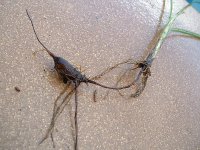That is actually not true. Acorns were originally the main starch staple and only later, in the late Bronze age, became the second choice after the grains...Everything is pointing to that.
If it was true, that acorns were the main staple of our ancestor's diet, we (as Europeans) would have developed a taste for them. The way we developed taste for mushrooms, many veggies and fruit, meat, wheat from chicken, pork, beef and starch from various grains. We don't have taste for acorns, therefore they didn't seem even close to being a main staple of hunter gatherer diet. I'm sure after few thousand years of eating acorns, as a main staple, we would have developed anti tannins genes, and even loved eating them, the way pigs or squirrels do. It is the same adaptation process which happened in us, to let us drink milk as adults, or enjoy and digest yogurts and cheeses, and is behind our love of eating fresh baked bread, good stake, broth with cooked fats. Our affinity to certain foods points to the way of life of our ancestors.
Acorns, not that much, we don't even make jams or pickles out of them. And for that reason I can definitely say that they were never a main staple in HGs diet.
People plant trees on purpose all the time. Every orchard is a bunch of purposely planted trees.
Can you show me any example of existing hunter gatherers planting trees? And not only sporadic trees. One would need to plant a forest with them to have steady supply of acorns, good enough quantity for the whole village main staple diet. Forrest would need to mature from seedlings too, and it takes about 50 years for oaks to mature, to give ample supply. That's twice the lifespan of average hunter gatherer! I don't think they had planned so much in advance, and were so patient. Especially if they used their time to hunt and find food in already rich forests of Europe.
Why the heck waste time planting and eating something that doesn't taste good and is poisonous, and to make it adable is labour and water intensive? It doesn't make sense unless one is starving and need to eat anything to survive.
If acorns were considered staple food then planting them would be the same as planting apples.
Can you give us example of HGs planting apples?
But oaks were not the only "first" European trees that were probably planted by people. Have a read at my article again and have a look at the list of trees and plants which first colonized Europe after the Younger Dryas. They were all edible and most had nuts and cones which can not be quickly dispersed by wind or animals. Do you think this is a coincidence?
Damn, they were not HGs, they were real farmers then. They planted and harvested through all Europe.
I think your concentration is very subjective and selective, and goes against discoveries in archeology. It is more "holistic" than anything.
And I agree with Angela, chestnuts are much better candidate for people to plant and use as food. If people didn't plant them for food, there is much chance they planted oaks for this purpose.
PS. I tried pickled chestnuts once. I liked the taste of them, the sweet with pleasant aroma, but I found the texture difficult to swallow.



